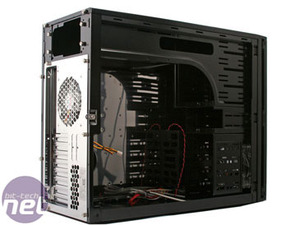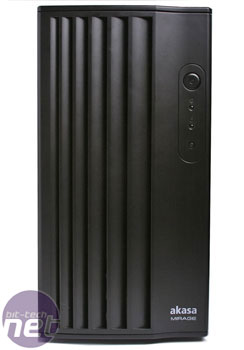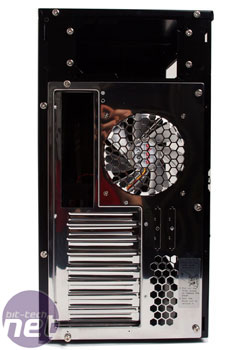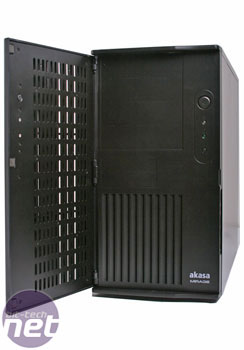Akasa Mirage-62
Manufacturer: AkasaUK Price (as reviewed): £99.86 (inc. VAT)
US Price (as reviewed): N/A
I must admit to being a little intimidated by being handed such a high profile case as the Mirage for my first review here at bit-tech. Its predecessor, the Akasa Eclipse, has a reputation among system builders and modders as a solid, customisable case, with unassuming looks and rock solid build quality. As a result, I immediately had high hopes for the Mirage.
But when I came to open the case up, it all seemed strangely familiar. The chromed removable motherboard tray, the extended girth, the drive cage configuration, they were all the same as the Eclipse.
After the feeling of déjà vu had passed, closer inspection revealed the Mirage is indeed nearly identical to the Eclipse in every way bar the updated fascia, which has eschewed the old flat front for that marmite of case design, a door. This isn't necessarily a bad thing, especially when you consider how well received the Eclipse was, but I had been hoping for a little more innovation considering the time since the Eclipse first launched.
However, as the old adage goes: if it ain't broke, don't fix it, so let's check this case out in a little more detail, and make sure nothing's gone wrong!
Oh My, It's A Mirage...
Externally, the Mirage continues the aesthetic style of the Eclipse, with some classic understated looks, although some could criticise it for being a little boring in this respect. The main body of the case is constructed of brushed black anodised aluminium, and the material just oozes quality.I'm a big fan of aluminium cases, as the material is not only hard wearing and surprisingly scratch resistant, it's also phenomenally light, perfect if you want to head off to a LAN with your case under one arm and your TFT under the other (N.B. – do not try to carry your hardware this way). While aluminium does mean a price premium over steel cases, the advantages certainly justify the extra cash.
The front fascia is bound to be controversial, as it's the only major difference between the Mirage-62 and Eclipse-62 – that's not to say it's the only difference though. While the flat plastic fascia remains, it has now been combined with a fully vented front door. Doors are a contentious issue in the world of cases, with some (myself among them) questioning their usefulness.
While I admit they can make the front of a case look tidier, the extra hassle in opening them to access drives or USB ports, and the obstruction they create for front intake airflow can render them more of a hindrance than a help. However, the Mirage's door avoids these faults to some extent, with some nifty design choices.
The power and reset buttons are mounted both in the front of the door and in the front of the case, while ventilation holes are cut along the full length of the door instead of using side intake vents which are almost universally poor. The front panel has been moved to the right hand side of the fascia, and while this avoids having to open the door to plug devices in, it means you'll need the case sat to your left.
This problem is heightened when you consider that the door is neither removable nor reversible, seriously limiting the options of where you keep your PC. The front panel itself consists of the usual line-up of two USB ports, Firewire and MIC/Stereo out (supporting both HD audio and AC97 via internal connectors), but is also joined by the welcome addition of eSATA.
The base of the case has the standard rubber four feet, but Akasa has also generously provided four coaster wheels if they're more your cup of tea (or like riding your PC down a toboggan run). Three separate aluminium panels clad the case's frame, and all are independently removable, allowing easy access from any side of the case. These featureless panels immediately grabbed me as a blank canvas for modders, and especially engravers, with the large featureless panels just begging for some custom designs and personalisation.
That's not to say the case isn't good looking from the off, just that it's a bit unremarkable, and needs an individual's touch to turn it into something spectacular. Size-wise, the case is extended both in width and length, measuring a meaty 240x460x560mm (WxHxD). This extra size, especially in the width, gives the Mirage a unique footprint and profile amongst higher end cases, as well as offering several advantages internally, as we'll now see...

MSI MPG Velox 100R Chassis Review
October 14 2021 | 15:04














Want to comment? Please log in.